Abstract
SF 86-327 is a new antimycotic agent of the allylamine type. Its primary action appears to be the inhibition of ergosterol biosynthesis at the point of squalene epoxidation, as was previously found with the related compound naftifine. Biosynthesis was measured by incorporation of [14C]acetate into sterols in cells of Candida albicans, Candida parapsilosis, Torulopsis glabrata, and the dermatophyte Trichophyton mentagrophytes. There was a positive correlation between the SF 86-327 concentrations needed for inhibition of growth and of sterol synthesis in these four fungi. The greater antifungal efficacy of SF 86-327 in comparison with naftifine was also reflected in the relative activities of the two compounds as sterol synthesis inhibitors. Inhibition was maximal at neutral pH. A similar degree of inhibition was found in cell-free extracts when [14C]mevalonate was used as substrate. In all cases, inhibition of sterol synthesis was accompanied by a parallel accumulation of labeled squalene. SF 86-327 and naftifine had no significant effect on initial enzymes of the ergosterol pathway, measured by incorporation of [14C]acetyl coenzyme A, or on steps distal to squalene epoxidation, measured by conversion of labeled squalene 2,3-epoxide or lanosterol. Both allylamines were highly selective for fungal, as opposed to mammalian, sterol biosynthesis. SF 86-327 caused slight inhibition of squalene epoxidation in a rat liver cell-free system, but at concentrations three to four orders of magnitude greater than those required for inhibition of the fungal pathway.
Full text
PDF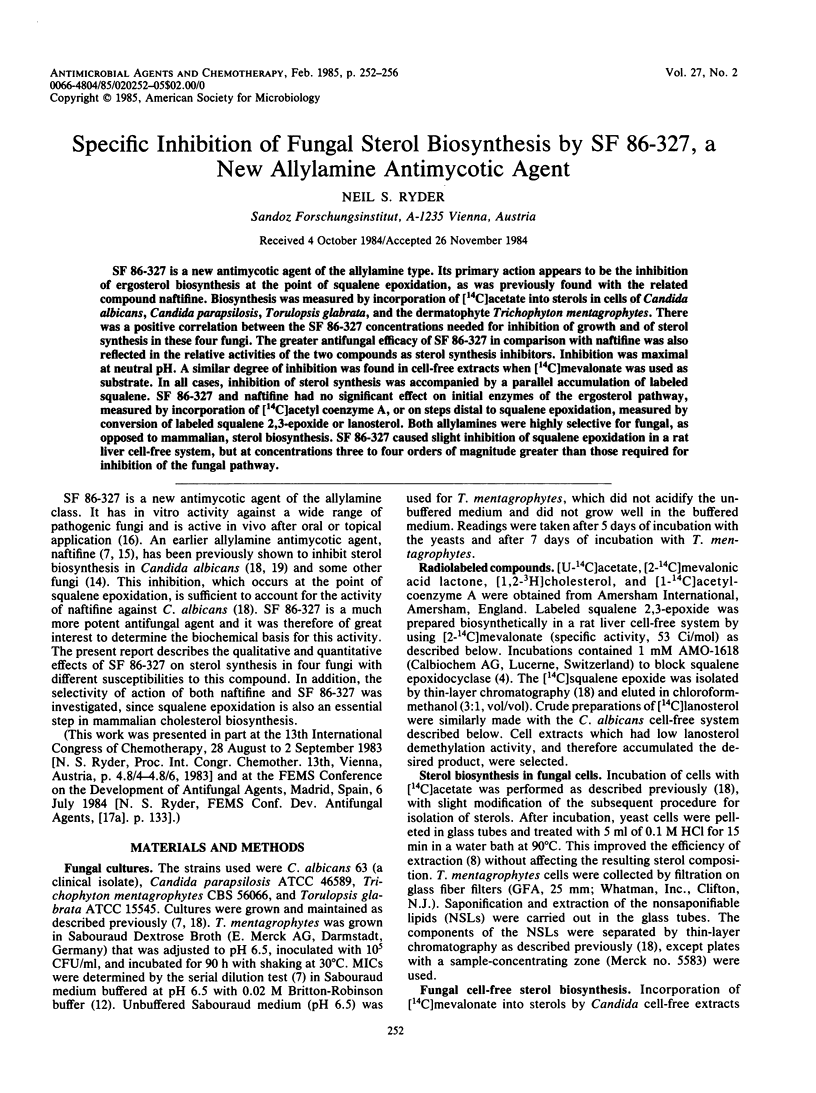
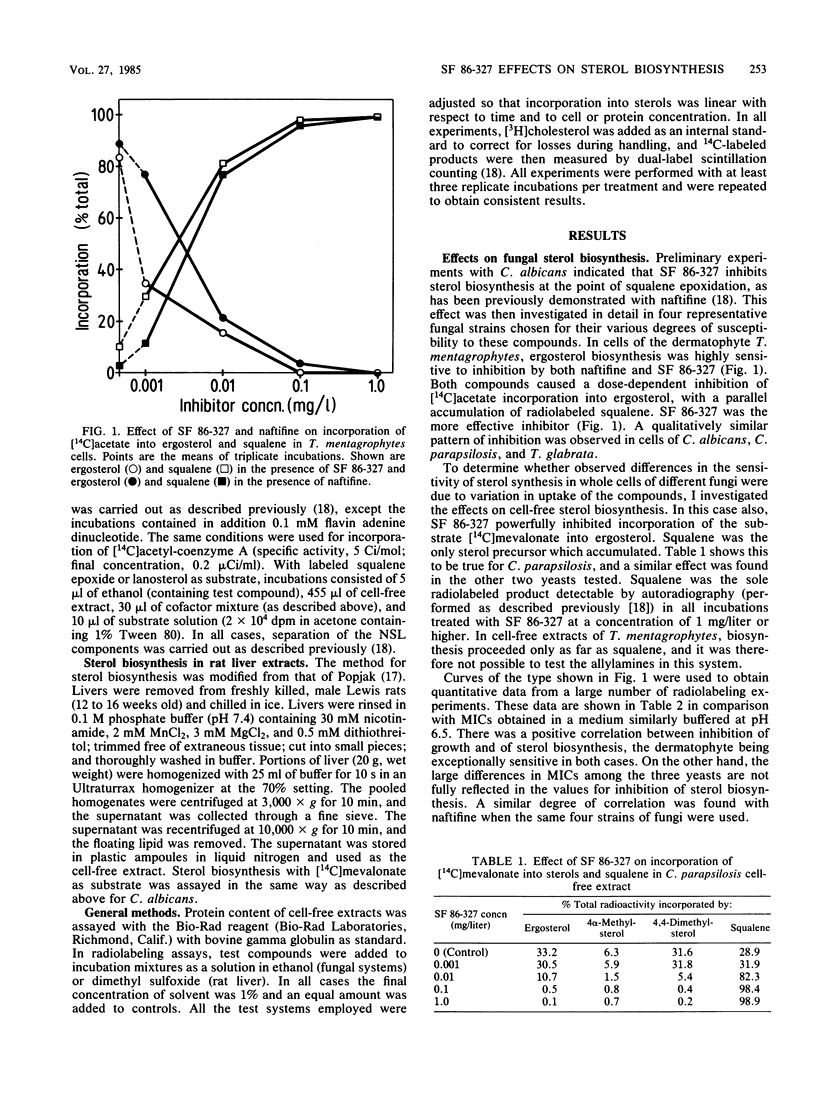
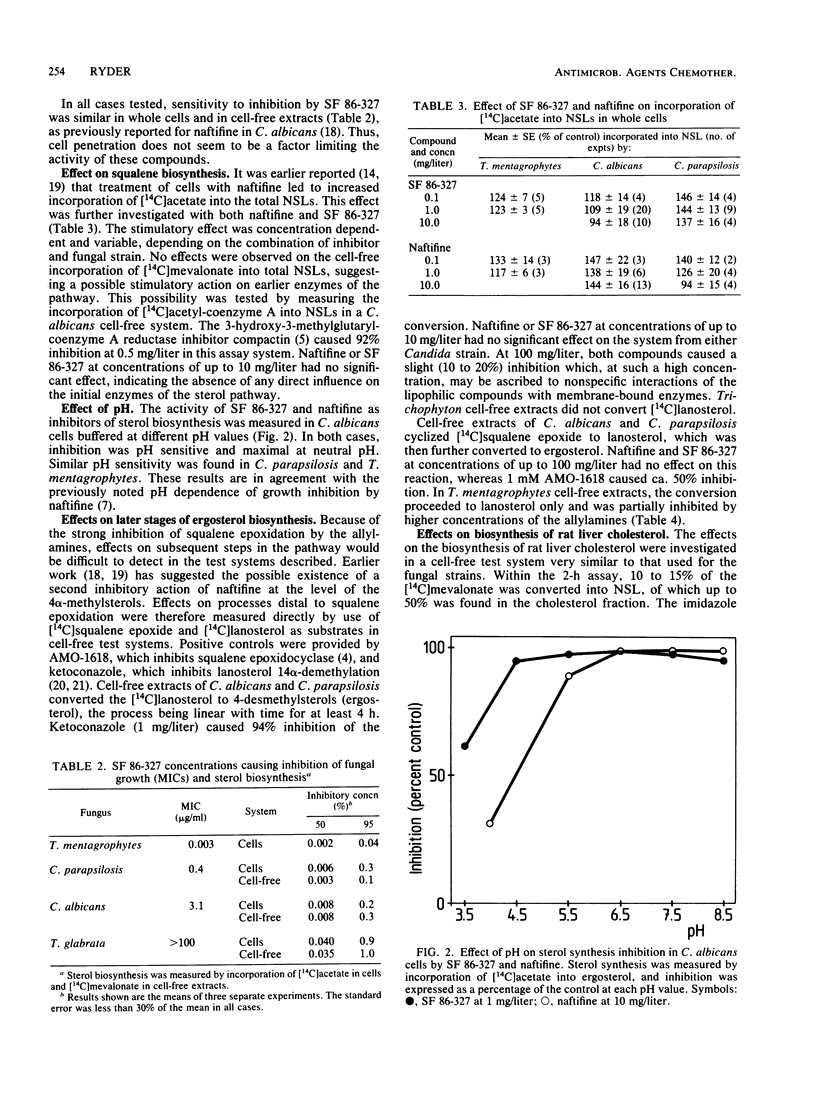
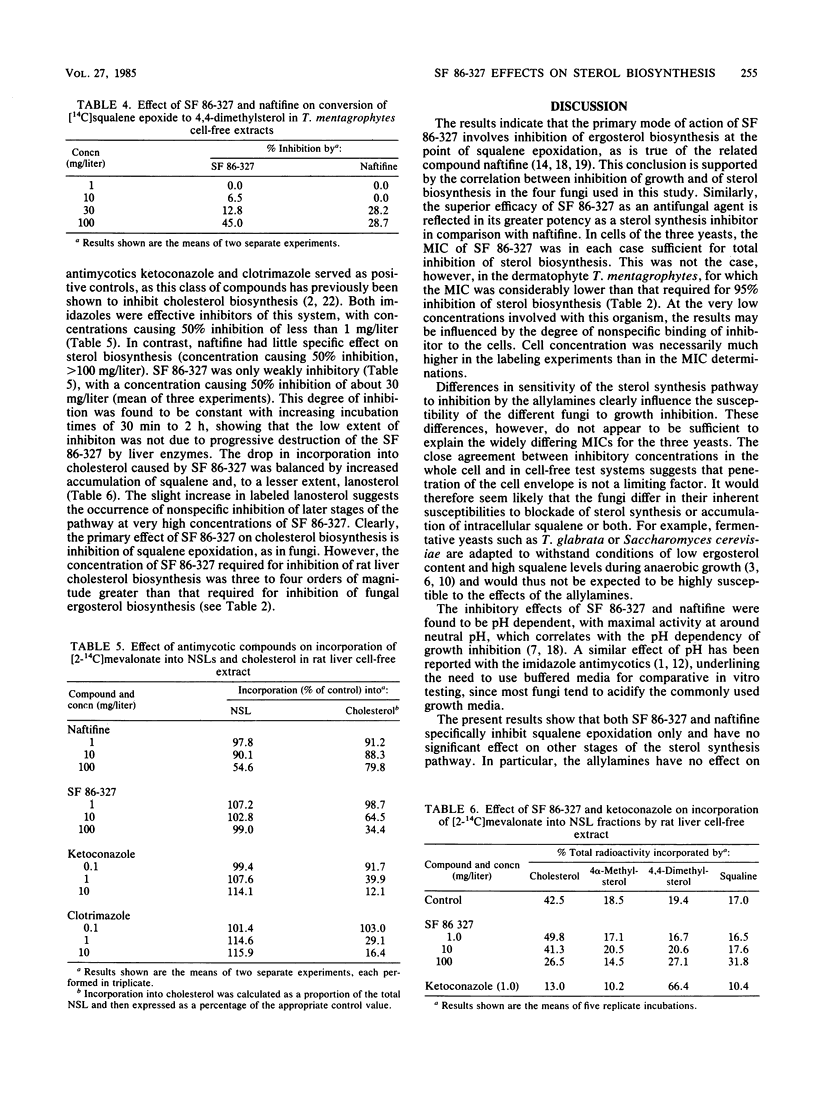
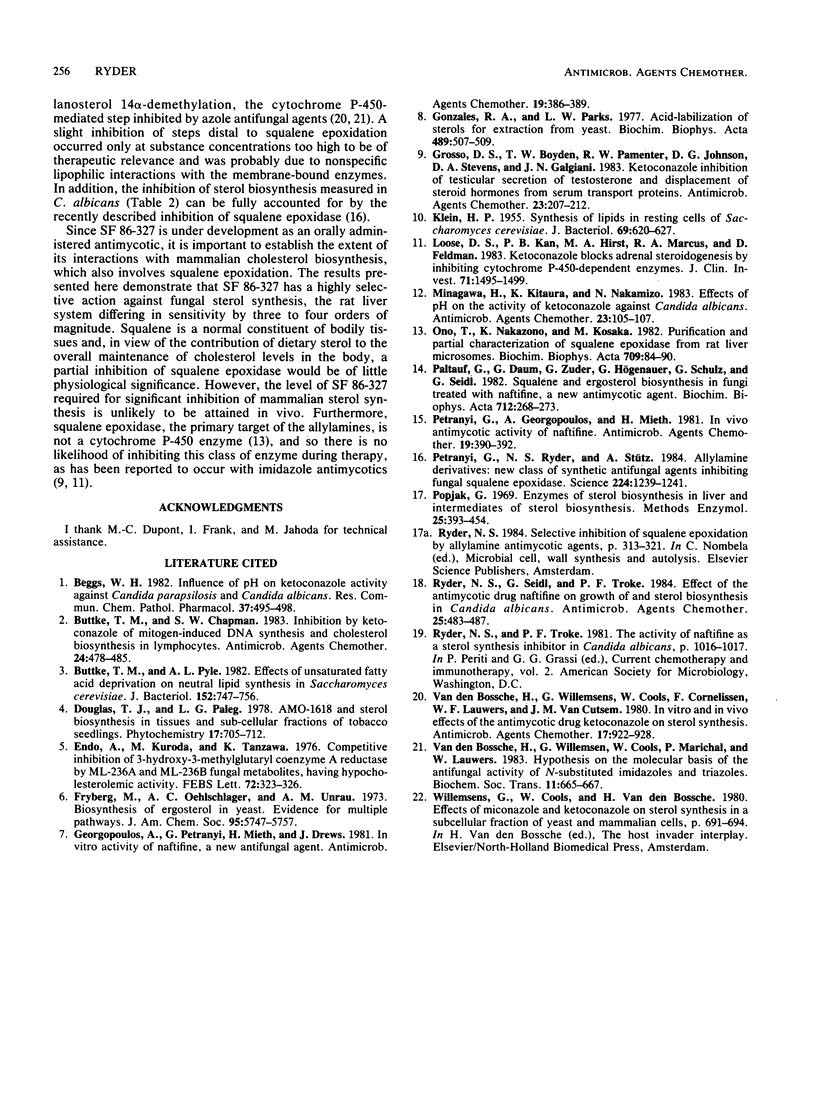
Selected References
These references are in PubMed. This may not be the complete list of references from this article.
- Beggs W. H. Influence of pH on ketoconazole activity against Candida parapsilosis and Candida albicans. Res Commun Chem Pathol Pharmacol. 1982 Sep;37(3):495–498. [PubMed] [Google Scholar]
- Buttke T. M., Chapman S. W. Inhibition by ketoconazole of mitogen-induced DNA synthesis and cholesterol biosynthesis in lymphocytes. Antimicrob Agents Chemother. 1983 Oct;24(4):478–485. doi: 10.1128/aac.24.4.478. [DOI] [PMC free article] [PubMed] [Google Scholar]
- Buttke T. M., Pyle A. L. Effects of unsaturated fatty acid deprivation on neutral lipid synthesis in Saccharomyces cerevisiae. J Bacteriol. 1982 Nov;152(2):747–756. doi: 10.1128/jb.152.2.747-756.1982. [DOI] [PMC free article] [PubMed] [Google Scholar]
- Endo A., Kuroda M., Tanzawa K. Competitive inhibition of 3-hydroxy-3-methylglutaryl coenzyme A reductase by ML-236A and ML-236B fungal metabolites, having hypocholesterolemic activity. FEBS Lett. 1976 Dec 31;72(2):323–326. doi: 10.1016/0014-5793(76)80996-9. [DOI] [PubMed] [Google Scholar]
- Fryberg M., Oehlschlager A. C., Unrau A. M. Biosynthesis of ergosterol in yeast. Evidence for multiple pathways. J Am Chem Soc. 1973 Aug 22;95(17):5747–5757. doi: 10.1021/ja00798a051. [DOI] [PubMed] [Google Scholar]
- Georgopoulos A., Petranyi G., Mieth H., Drews J. In vitro activity of naftifine, a new antifungal agent. Antimicrob Agents Chemother. 1981 Mar;19(3):386–389. doi: 10.1128/aac.19.3.386. [DOI] [PMC free article] [PubMed] [Google Scholar]
- Gonzales R. A., Parks L. W. Acid-labilization of sterols for extraction from yeast. Biochim Biophys Acta. 1977 Dec 21;489(3):507–509. doi: 10.1016/0005-2760(77)90171-0. [DOI] [PubMed] [Google Scholar]
- Grosso D. S., Boyden T. W., Pamenter R. W., Johnson D. G., Stevens D. A., Galgiani J. N. Ketoconazole inhibition of testicular secretion of testosterone and displacement of steroid hormones from serum transport proteins. Antimicrob Agents Chemother. 1983 Feb;23(2):207–212. doi: 10.1128/aac.23.2.207. [DOI] [PMC free article] [PubMed] [Google Scholar]
- KLEIN H. P. Synthesis of lipids in resting cells of Saccharomyces cerevisiae. J Bacteriol. 1955 Jun;69(6):620–627. doi: 10.1128/jb.69.6.620-627.1955. [DOI] [PMC free article] [PubMed] [Google Scholar]
- Loose D. S., Kan P. B., Hirst M. A., Marcus R. A., Feldman D. Ketoconazole blocks adrenal steroidogenesis by inhibiting cytochrome P450-dependent enzymes. J Clin Invest. 1983 May;71(5):1495–1499. doi: 10.1172/JCI110903. [DOI] [PMC free article] [PubMed] [Google Scholar]
- Minagawa H., Kitaura K., Nakamizo N. Effects of pH on the activity of ketoconazole against Candida albicans. Antimicrob Agents Chemother. 1983 Jan;23(1):105–107. doi: 10.1128/aac.23.1.105. [DOI] [PMC free article] [PubMed] [Google Scholar]
- Ono T., Nakazono K., Kosaka H. Purification and partial characterization of squalene epoxidase from rat liver microsomes. Biochim Biophys Acta. 1982 Dec 6;709(1):84–90. doi: 10.1016/0167-4838(82)90424-1. [DOI] [PubMed] [Google Scholar]
- Petranyi G., Georgopoulos A., Mieth H. In vivo antimycotic activity of naftifine. Antimicrob Agents Chemother. 1981 Mar;19(3):390–392. doi: 10.1128/aac.19.3.390. [DOI] [PMC free article] [PubMed] [Google Scholar]
- Petranyi G., Ryder N. S., Stütz A. Allylamine derivatives: new class of synthetic antifungal agents inhibiting fungal squalene epoxidase. Science. 1984 Jun 15;224(4654):1239–1241. doi: 10.1126/science.6547247. [DOI] [PubMed] [Google Scholar]
- Ryder N. S., Seidl G., Troke P. F. Effect of the antimycotic drug naftifine on growth of and sterol biosynthesis in Candida albicans. Antimicrob Agents Chemother. 1984 Apr;25(4):483–487. doi: 10.1128/aac.25.4.483. [DOI] [PMC free article] [PubMed] [Google Scholar]
- Van den Bossche H., Willemsens G., Cools W., Cornelissen F., Lauwers W. F., van Cutsem J. M. In vitro and in vivo effects of the antimycotic drug ketoconazole on sterol synthesis. Antimicrob Agents Chemother. 1980 Jun;17(6):922–928. doi: 10.1128/aac.17.6.922. [DOI] [PMC free article] [PubMed] [Google Scholar]
- Van den Bossche H., Willemsens G., Cools W., Marichal P., Lauwers W. Hypothesis on the molecular basis of the antifungal activity of N-substituted imidazoles and triazoles. Biochem Soc Trans. 1983 Dec;11(6):665–667. doi: 10.1042/bst0110665. [DOI] [PubMed] [Google Scholar]


